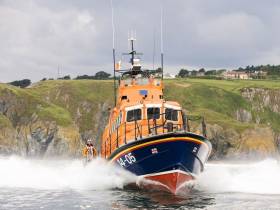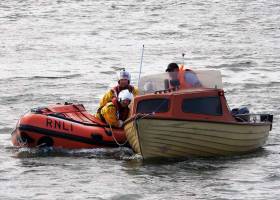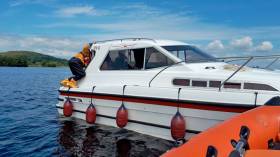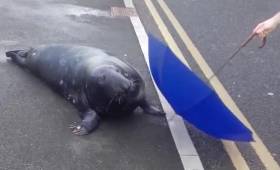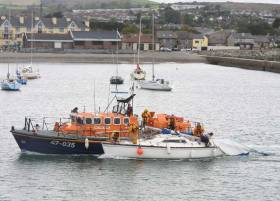Displaying items by tag: Wicklow
Lifeboat Changes At Wicklow RNLI Signal Major Investment In Historic Station
#Lifeboats - As noted by Tom MacSweeney in his latest podcast, Wicklow is the last RNLI station with a Tyne class lifeboat in service.
Before the current Tyne lifeboat Annie Blaker is officially taken off service later this year, it will be replaced by a relief Shannon class lifeboat — the fastest and most technologically advanced class in the fleet.
The Shannon class Jock and Annie Slater is due to arrive in Wicklow on Sunday 24 February at 2:30pm.
Annie Blaker has been the busiest all-weather lifeboat in the history of the station, being involved in over 340 services, rescuing over 400 people.
It will be a bittersweet time for the crew, station management and fundraisers with the arrival of the new lifeboat and the departure of Annie.
The relief lifeboat, which will eventually be replaced by a permanent Shannon for Wicklow in a few years’ time, will have a temporary berth at the South Quay.
Each lifeboat class has a unique slip to launch from and as the Shannon is very different to the Tyne class, this temporary mooring near the station will support it until Wicklow receives its permanent Shannon lifeboat.
Work will need to be undertaken to support the changes at Wicklow and this will be undertaken in full consultation with relevant stakeholders.
Commenting on the changes, Wicklow RNLI lifeboat operations manager Des Davitt said: “The confidence displayed by the RNLI Council and trustees, who have given the go-ahead for this major investment, is a testament to the service of all crew, committees and fundraising teams, past and present.
“History is in the making as the newest, fastest, state-of-the-art lifeboat is about to arrive. Already our coxswains and mechanics have attended training in Poole and a crew from our station has been tasked with bringing the Shannon class lifeboat into Wicklow on Sunday 24 February where the rest of the crew will receive training from the fleet staff coxswains.
“Over the next three years major work will be carried out on the station and slip to accommodate the arrival of our own Shannon in early 2022. None of this would be possible without the magnificent support of the people, businesses and organisations of Wicklow and environs.
“It is an exciting time for all involved and indeed for the people of Wicklow.”
Dun Laoghaire & Wicklow Lifeboats Launch To Paddle Boarder In Distress
#Lifeboats - Dun Laoghaire RNLI responded to a stand-up paddle boarder who got into difficulty between Bray Head and Greystones yesterday afternoon (Sunday 27 January).
The volunteer lifeboat crew were requested to launch their all-weather lifeboat at 12.03pm and were on the water at 12.20pm.
The Irish Coast Guard helicopter Rescue 116 and Wicklow RNLI’s all-weather lifeboat were also tasked to the incident south of Bray Head.
Weather conditions were not good, with strong gale-force winds.
Dun Laoghaire’s crew of seven spotted the casualty who was clinging to his board and appeared in trouble.
Thirty-nine minutes after launch, the crew had the casualty onboard their lifeboat and quickly assessed he was suffering from “serious hypothermia”.
The casualty was airlifted to hospital by the coastguard. Wicklow RNLI recovered the paddle board and stood by as the casualty was winched onto the helicopter.
Commenting after the callout, Dun Laoghaire RNLI second coxswain Eamon O’Leary said: “The paddle boarder had suffered serious hypothermia when we arrived on the scene.
“It was a close call but he did the right thing in calling the coastguard who were quick to send out 116 along with Wicklow RNLI. It was fantastic teamwork by all involved.”
Flooded Homestead Re-emerges From Wicklow Reservoir
#Poulaphuca - The remains of an old homestead submerged by the Poulaphuca Reservoir have resurfaced, as RTÉ News reports.
Images captured by the Garda Air Support Unit in Wicklow clearly show the ruins of a house and a piece of farm machinery.
The ‘island’ was revealed by the retreat of reservoir waters in the recent summer drought that saw remarkable archaeological finds nationwide — as well as an ‘ÉIRE’ sign on Bray Head dating from the Second World War.
While patrolling the Wicklow division The Garda Air Support Unit noticed the ruins of a homestead and a piece of farm machinery (mowing bar) on a raised piece of land which had previously been submerges in the lakes. pic.twitter.com/JIco4vlgit
— An Garda Síochána (@GardaTraffic) September 14, 2018
The farm was one of a number of properties abandoned before the valley was flooded to create Poulaphuca in 1940.
Wicklow Lifeboat Aids Angling Boat With Mechanical Failure
#RNLI - A small angling boat with one person on board was towed to safety by Wicklow RNLI after it got into difficulty near Wicklow Head on Wednesday evening (8 August).
The angler had earlier departed from Wicklow Port for a day’s fishing along the coast, but was unable to get the engine into gear to return to the harbour.
The inshore lifeboat launched shortly after 6pm with helm Vinnie Mulvihill and crew David O’Leary and Graham Fitzgerald, and located the drifting craft near Wicklow Head eight minutes later. Weather conditions at the scene were calm with a northerly wind force three.
The angling boat was taken in tow back to Wicklow Harbour and the angler was landed safely ashore.
Elsewhere, Clifden RNLI continued what’s been a busy August when the volunteer lifeboat rescued a boy separated from his kayak at Omey Island earlier on Wednesday afternoon.
The youngster and his friend were holidaying on the island in Claddaghduff with their families, who raised the alarm when one of the boys was seen in the water with his friend trying to help him.
Following the coastguard request after 2.30pm, the Atlantic 85 lifeboat launched from Clifden while the D Class lifeboat travelled by road and was launched at Claddaghduff. Winds were Force 6 and gusting to 7 at the time.
When the Atlantic 85 reached the scene, they found people waving from the eastern shore of the island and saw that the two boys involved had made it ashore to another beach in the area, where some other visitors were assisting them.
Clifden RNLI helm Thomas Davis manoeuvred the lifeboat close to the shore and crew member James Mullen then swam to attend to the boys before reuniting them with their families. They were cold and shaken after the ordeal but otherwise unharmed.
Speaking after the callout, Mullen said: “We were really glad to have been able to assist these lads and their families today and always encourage anyone concerned to raise the alarm as quickly as possible.
“Conditions at sea in this area can change rapidly even for experienced water users and we are always on hand to help where we can.”
The RNLI advise all kayakers to always carry a means of calling for help and to keep it in reach at all times.
More recently, Carrybridge RNLI’s rescue water craft and inshore lifeboat Douglas Euan & Kay Richards, were requested to launch by Belfast Coastguard to assist a man who was disorientated whilst navigating Tamlaght Bay in Upper Lough Erne in the early hours of this morning, Friday 10 August.
And Larne RNLI’s all-weather lifeboat and inshore lifeboat crews recently carried out a training exercise to simulate a casualty care and extraction scenario.
Wicklow Lifeboat Assists Yacht Taking On Water
#RNLI - Wicklow RNLI’s all-weather lifeboat Annie Blaker launched shortly after 3.10pm yesterday afternoon (Sunday 22 July) after the skipper of a yacht taking on water called for assistance.
The lifeboat — under the command of coxswain Nick Keogh and with mechanic Brendan Copeland and crew Ciaran Doyle, Terry Silvery, Dave O’Leary and Graham Fitzgerald — was alongside the casualty vessel six minutes after launching, one mile north of Wicklow Harbour.
Crew member O’Leary was transferred onto the yacht to assess the boat and help establish a towline.
The yacht was then towed back to Wicklow Harbour without further incident and the two sailors were landed safely ashore on the East Pier at 3.30pm.
#RNLI - Both Wicklow RNLI lifeboats were launched yesterday (Sunday 1 July) to assist two people on an inflatable dinghy near Brittas Bay beach.
The father and son had set off from the popular tourist beach to fish in a small inflatable dinghy but were carried offshore south around Mizzen Head with the wind and tide, and were having difficulties rowing back to land.
Fortunately, the father managed to get the dinghy ashore on an inaccessible beach after much effort.
Onlookers and family members were unable to get down the cliff to help them, so they waited until the inshore lifeboat came ashore at 5.30pm and was able to pick up the stranded man and son.
They were transferred to the all-weather lifeboat a short time later and assessed by lifeboat first aider Carol Flahive.
The Dublin-based Irish Coast Guard helicopter Rescue 116 was also tasked to the incident.
The two casualties were cold and shaken after their ordeal, but required no further medical assistance. They were landed safely back at Wicklow lifeboat station at 6.30pm and were picked up by relieved family members after having a hot drink.
Speaking following the callout, Wicklow RNLI volunteer lifeboat press officer Tommy Dover said: “We would remind everyone planning an activity at sea to always respect the water. Always wear a lifejacket or buoyancy aid. Always carry a means of calling or signalling for help.
“Check the weather and tide times before you go. Tell someone about your plans - where you intend to go and when you expect to return.”
#RNLI - A busy Bank Holiday Sunday (3 June) for RNLI lifeboat callouts began just after 9am, when Baltimore RNLI was tasked to a yacht that ran aground upriver from the West Cork village.
The vessel, with two on board, got into difficulty while trying to navigate the River Ilen near Old Court. Conditions at the time were described as good but the tide was falling.
Baltimore’s inshore lifeboat, with helm John Kearney and crew members Ian Lynch and David Ryan, arrived on scene at 9.27am.
After assessing the situation and checking the area around the vessel for any further navigational hazards, a tow was established and the yacht was pulled clear.
There was no apparent damage to the yacht and no injuries to anyone on board, so they continued on their journey down the river and the lifeboat returned to station.
Later in the morning, Wicklow RNLI launched to a 13m fishing vessel that suffered engine failure off the Wicklow coast.
The all-weather lifeboat Annie Blaker, under the command of coxswain, Nick Keogh launched shortly before 11am and was alongside the stricken vessel 50 minutes later, near Bray Head.
Conditions on scene had a sea state slight, with a south-westerly Force 3 wind and poor visibility due to fog.
Two lifeboat crew members were transferred onto the fishing vessel to assist with establishing a towline and assess one of the three fishermen on board, who was found to have sustained an arm injury. He received first aid and casualty care from Carol Flahive and Alan Goucher as the vessel was towed back to Wicklow harbour.
The fishing vessel was brought safely alongside the South Quay in Wicklow at 2pm and the injured fisherman was handed into the care of an ambulance crew.
A third callout was at Lough Derg on the Shannon, where a cruiser with two on board had run aground at Tullabeg over lunchtime.
The Lough Derg lifeboat was on scene within minutes as the crew were already in the area on exercise.
Once established that the boat had no structural damage and the two people on board were fine, the vessel was towed into deeper water to allow its journey to continue.
“With the good weather continuing there are a lot more people on the water,” Lough Derg RNLI helm Owen Cavanagh said. “We would always advise to plan any water-based activity well in advance and if out on a boat to make proper preparations for the trip, including taking the correct equipment and keeping a close eye on the surroundings.”
RNLI Lifeboats In Medevac Shouts At Baltimore & Wicklow
#RNLI - Baltimore RNLI carried out a medevac on Saturday night (12 May) from Cape Clear Island off the coast of West Cork.
The volunteer crew were requested to launch their all-weather lifeboat by the Irish Coast Guard at 8.05pm to provide medical assistance and evacuation to a man working on the island.
Arriving in Cape Clear at 8.24pm, the RNLI volunteers transferred the casualty onto the lifeboat and returned him to Baltimore lifeboat station, whee he was handed over to the care of a waiting HSE ambulance crew.
Conditions at sea during the shout were calm with a south-westerly Force 3 wind and half-metre sea swell.
“So far this year medical evacuations make up a high percentage of the call outs for Baltimore lifeboat,” said Kate Callanan, Baltimore RNLI volunteer lifeboat press officer.
“Acting as an ambulance between the islands off the coast of West Cork is a vital service and our volunteer crews are trained to a high standard in first aid and casualty care.
“If you find yourself at sea or on an island in need of medical assistance, call 999 or 112 and ask for the coastguard.”
Hours later, Wicklow RNLI’s inshore lifeboat crew were alerted by pager shortly after 3.10pm yesterday afternoon (Sunday 13 May) to assist in the medic of an injured sailor in the town’s harbour.
The sailor was being treated on a yacht by first responders and HSC paramedics at the East pier after he sustained injuries while sailing in Wicklow Bay.
The lifeboat was requested to launch in case the casualty was seriously injured and needed to be evacuated from the yacht to a more suitable location for transfer to an ambulance.
The lifeboat, with helm Alan Goucher and crew Terry Sillery and Paul Sillery, was about to launch when lifeboat operations manager Des Davitt was made aware that the casualty was assisted up a ladder onto the pier after being treated by paramedics, and no further assistance was required.
Wicklow’s Hungry Seal Goes Viral Again
#MarineWildlife - Twitter user Derek Byrne was bemused by the sight of a large seal being chased from the door of a fishmonger’s as he drove through Wicklow town on Wednesday afternoon.
But for the townsfolk, Sammy the Seal has long been something of a local celebrity — or nuisance, if you ask the staff of The Fishman on South Quay.
They might well be saying that with tongue firmly in cheek, however, given that a sign across the street says ‘seal crossing’ and that T-shirts sporting an image of the gregarious seal can be purchased nearby, as the Guardian reports.
Just witnessed this giant seal being chased out the door of a fishmongers shop in Wicklow town. pic.twitter.com/WGlGxlAWfs
— Derek Byrne (@Derek1052) November 22, 2017
Indeed, Afloat.ie readers may remember when Sammy last appeared here in February 2016 — after one of his regular forays from the River Vartry for fishy snacks as thwarted at the end of an umbrella.
Yet despite the local fondness for Sammy, and the seal’s growing internet notoriety, Alan Hegarty of The Fishman and the adjacent Lighthouse Restaurant warns: “At the end of the day he is a wild animal and we want him to remain that way.”
Wicklow Lifeboats Launch To Help Dismasted Yacht
#RNLI - Wicklow RNLI’s all-weather and inshore lifeboats launched yesterday afternoon (Sunday 1 October) after a 9m yacht with three people on board was reported to have lost its mast and rigging while racing in Wicklow Bay.
The all-weather lifeboat was alongside the dismasted yacht four minutes after launching at 3.30pm. Three lifeboat crew boarded the yacht and, as a precaution, two children were transferred from the stricken vessel onto the lifeboat.
Meanwhile, the inshore lifeboat crew were tasked with recovering the mast and sail from the sea, which were still connected by rigging to the yacht.
Once the mast and sail were recovered and secured, a tow line was established and the yacht was returned to Wicklow Harbour, where it was safely secured alongside the South Quay. Thankfully no one was injured during the incident.
Conditions at the scene had a westerly Force 3 wind with good visibility and a slight sea state.
The crew on this callout on the all-weather lifeboat were second coxswain Ciaran Doyle, mechanic Connie O'Gara, David O’Leary, Graham Fitzgerald, Vinny Mulvihill, Peter McCann, Joe Hanlon and John Stapleton. On the inshore lifeboat were helm Alan Goucher, Lisa O’Leary and Dean Mulvihill.



























